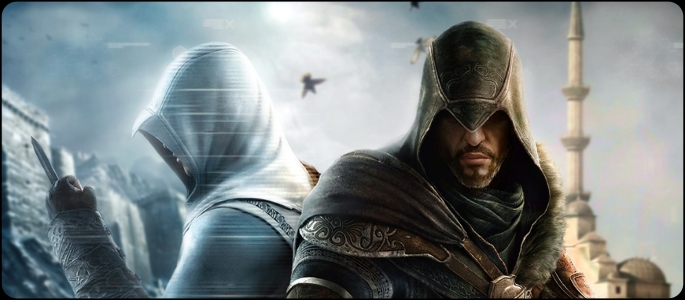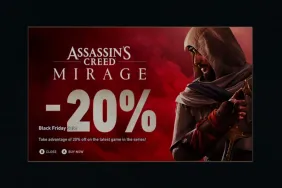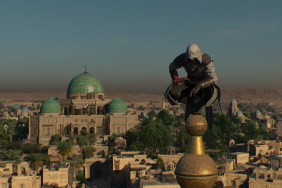Assassin’s Creed Revelations is the fourth game in the main series, but, despite the franchises premise of time-travel to any era, remains focused on Ezio Auditore. Has the annual release cycle meant that the series has become stale, or can Ubisoft pull off another winning title?
While Desmond’s story starts soon after the events of Brotherhood, we join Ezio far later on in his life, with an intro cutscene charting the aged Assassin’s course to Masyaf, the castle that was the home to the Assassin Order in the original Assassin’s Creed game.
When you arrive at Masyaf, it’s clear that time has passed, with the stones and structures all looking worse for wear. The perpetually-sunny Masyaf has been replaced by a bleak, windy fortress that is being battered by a heavy snowstorm. Due to the poor visibility, stealth is far simpler, and can be more satisfying. It’s an enjoyable start to the game, but you do miss the changing weather when you reach Constantinople.
Also known as Istanbul, Constantinople sits right on the edge of Europe and Asia, with the huge Turkish Strait, breaking the city into two parts, with one side part of Europe, and the other Asia. This leads to a wonderful medley of cultures, with Ottoman and Islamic themes at the forefront, but with a pervasive European flavor added to structures and clothing.
Unfortunately, the Bosphorus – while geographically accurate – is truly immense, so swimming across it would take forever, meaning that your routes across the city always have to include the limited ferry points that dot the waterside.
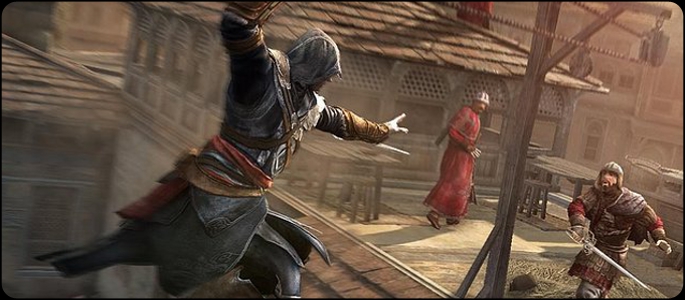
Beneath Constantinople, there is a network of vast waterways, which are only accessible during certain single-player missions. In them, you must make your way along the sides of the huge caverns without falling to your death, or being knocked off by the gushing water that spews out of the walls. The scaffolding that serves as your pathway is rotten with damp, and if you linger too long, you will plunge to your death, making for an exciting and enjoyable level.
Another location in the game is a small underground city controlled entirely by the Byzantines. While different to Constantinople, the city doesn’t offer much new, other than the fact it is inside a mountain. One of the more enjoyable aspects of the new location is fact that it’s home to some of the longest ziplines, which can be a real thrill to ride along.
These ziplines are also placed all Constantinople, and act as a quick way to navigate across rooftops. To do so, you use a new addition to the Assassin’s Creed franchise – the hookblade. A gift from your Turkish Assassin friends, the hookblade acts as an extension of Ezio’s arm, and shoots out to reach places that would normally be beyond your grasp. This new climbing mechanic doesn’t overhaul the system, but it improves it, making the simple run-and-jump parkour style a little more complicated.
You can also use the hookblade as a non-lethal weapon, with Ezio able to hook onto an enemy while running, and then roll over their back, and so keep on running. You can also trip people up by using the hook to drag people’s feet from under them, knocking them to the floor without desynchronizing. In killstreaks, the hookblade occasionally appears as a secondary weapon, grabbing onto victims and pulling them onto your blade.
Another weapon you can use is the bomb, which you can purchase or craft with ingredients you find. While there are several hundred variations of bomb, they all stick to three main categories – distraction: these bombs flash or bang to attract the guards’ attention, escape: these bombs produce smoke or drop caltrops to slow down anyone chasing you, and attack: these bombs are thrown to kill your enemy, and are basically old fashioned grenades. Depending on your ingredients, you can control things like the strength of the blast, or how long it takes to explode.
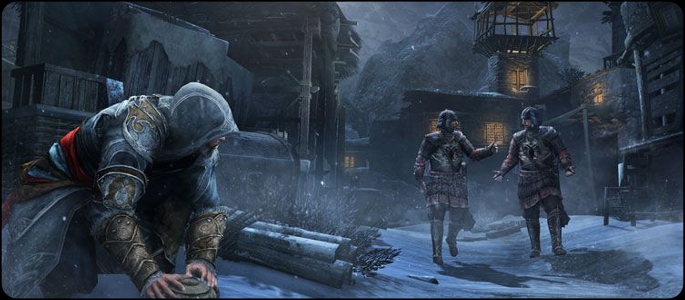
Combat as a whole hasn’t changed much, but is slightly more fluid and streamlined. In addition to being able to counter moves, you can ‘counter steal’, essentially pickpocketing an enemy mid-fight. But perhaps the biggest change to the combat is not in the actual gameplay, but in the adversary. Tougher foes like the Janissary can shrug off multiple blows, can’t be countered and, worst of all, will shoot you with a handgun when your back is turned. They are a great challenge for long-term series players, but might be a bit too difficult for newcomers.
Unless you set out to fight the Janissaries, you won’t face them outside of story missions. The Ottomans as a whole are not your enemy, and they will even protect you from the Templar-controlled Byzantines who are out to kill you. The Ottoman Empire controls Constantinople, but evil Templars roam the streets looking for Assassin’s to fight, and districts to take control over.
Controlling districts is an important side aspect of Revelations. To take control of an area, you need to kill the Templar captain that is in charge of the district and then light a beacon on the tallest tower to let the Templars know that it’s in their best interest to clear out. In doing this, you gain control of the district and set up an Assassin’s den, allowing you to recruit more assassins (which you can call upon in fights, like in Brotherhood).
But taking control of a district is not the end of the battle – if your notoriety rises too far because of your mass murdering, pick pocketing ways, the Templars will mount an attack on one of your dens, making it a ‘contested zone’. Here, you are introduced to another new gameplay mechanic: Den Defense. Much like classic tower defense games, you have to lay barricades and place various different assassins on the rooftops to fight several waves of Templar. Strategy is key in later fights, with your limited morale points having to be spent wisely on the right barricade or the right type of assassin. It’s a nice change of pace, and can get your blood pumping, despite being based on such an over-crowded genre. Plus, if you’re not a fan of the mini-game, Den Defense only occurs once in the main story line.
Keeping control of zones is vital to earning more money, as you can’t renovate shops and so gain an income from any buildings in a Templar-owned district. Like in Brotherhood, the money can then be spent on clothes, maps, armor and weapons.
But Den Defense is only one of the many, many side-missions that can be given by other factions like the thieves and the Roma travelers. Unfortunately, like many of the main missions, the majority of missions focus on either tailing or killing an individual, which can become rather repetitive.
Some main story missions do change things up, with one level requiring you to dress up as a minstrel and distract party revelers by singing at them while your colleagues kill the Templars among them. Another level later on focuses on a much more aggressive horse-drawn carriage journey than in previous games, and requires you to ram other carriages until they disintegrate. Without spoiling things, that mission then becomes even more exciting.
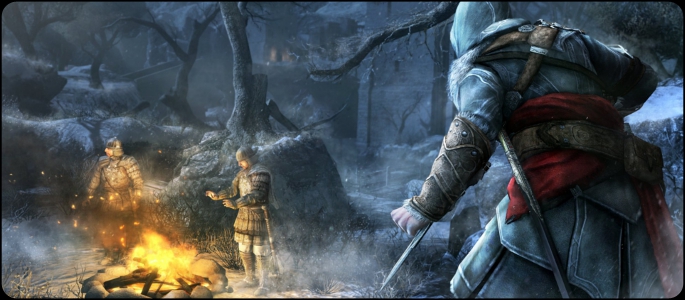
As you progress through the single-player campaign, you will be treated to flashbacks of Altaïr, the assassin from the first Assassin’s Creed. The flashbacks – which are fully playable – show you what happened to the 9-fingered killer after the end of the original game, with each one showing a different moment in his life. It’s a great way to revisit locations in the first game, and also answers many questions about Altaïr’s life.
Desmond is once again a huge part of the game, and his storyline progresses throughout the main story missions. However, his part here is purely to listen to people while he is in a coma and to learn stuff about the Animus he is in. The real treat is in the optional side missions which explore Desmond’s past. On the Animus Island – a virtual construct which Desmond finds himself in – there are various doorways which lead to Ezio and the past, or to the side missions. The missions start off slow, with Desmond walking along in first person while he recounts his childhood, but they quickly become interesting. The idea of a first person Assassin’s Creed might make you initially think of Mirror’s Edge, but forget that – Desmond can’t run, he can’t climb walls and he can only jump a little. In fact, the missions are more like a cross between LittleBigPlanet, Tetris and Portal. You are faced with numerous obstacles and sheer drops which must be navigated by constructing a pathway in front of you. You can literally summon a Tetris-style horizontal block that you can walk across, or a ramp to walk up. At first, these float in the air and crossing chasms is easy, but later levels require you to traverse levels that have areas where your platform moves (much like the blue tunnels in Portal 2), or that disintegrate the platform you are standing on. The puzzles aren’t too difficult, but with a little more depth they would make a decent PSN game all on their own.
The game also includes multiplayer, which is an improvement over the multiplayer introduced in Brotherhood, but not a complete overhaul. The general cat-and-mouse missions remain the same, and still often end in a pile-up of kills, but there are new modes like one where you must not become infected with the plague, and if you do must infect other gamers, which is set during the crusades.
Much of the setup has been streamlined, now, instead of quitting to choose a layout, you can choose the layout every time you spawn, but this time you are required to purchase any abilities with Abstergo Credits, rather than simply unlocking them as you play.
Another new feature is contested kills, where you can semi-stun an opponent by punching him/her just as they stab you. This won’t get you as many points as the killer gets for ending your life, but is a nice way to feel like you’re not completely harmless. Bombs are also used more, with tripwires and booby traps essential to staying hidden.
Graphically, Revelations is an improvement, but not wildly so. There are some locations that could have been added to Brotherhood, or even II without a player noticing. Another problem is that people’s faces are re-used far too much – in one in-game cutscene a guard even talks to an identical version of himself, before being told off by a captain who looked suspiciously like every shop keeper in the city.
Revelations is a fantastic game, and is more than worth your money, but a repetitive mission structure and the fact that the game is still following Ezio is rather disappointing. Overall, the positives far outweigh the negatives, with the game an improvement over Brotherhood in almost every way, making it one of this holiday’s must-haves.
PlayStation LifeStyle’s Final Score
+ Makes Desmond interesting. – Still set in the same era. |
 |
–
